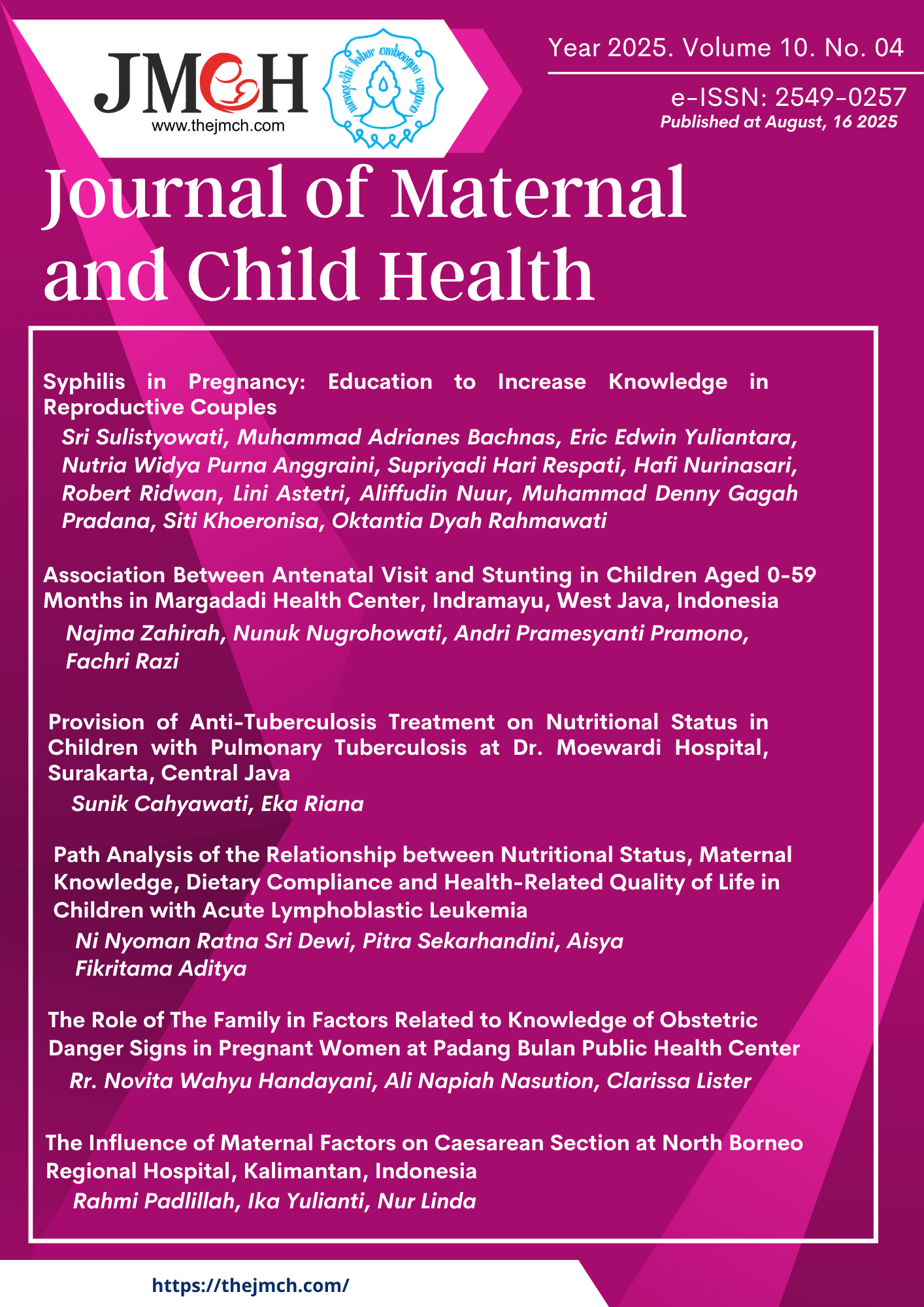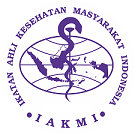Family Role on the Pregnant Women’s Knowledge Toward Obstetric Danger Signs
DOI:
https://doi.org/10.26911/thejmch.2025.10.04.05Abstract
Background: Obstetric danger signs are an important indicator that pregnant women need to recognize to prevent complications and reduce maternal mortality. This study aims to analyze the determinants of knowledge about obstetric danger signs in pregnant women, with a special focus on the role of family function as measured by the family APGAR instrument.
Subjects and Method: A cross-sectional study was conducted on 48 pregnant women who visited the Padang Bulan Community Health Center, Medan, during August-September 2024. The dependent variable is the level of knowledge about obstetric danger signs. Independent variables were age, education level, employment status, number of pregnancies (parity), income, and family function (APGAR score). Data collection was conducted using questionnaires on obstetric danger signs and family APGAR instruments. Data analysis included univariate, bivariate (Chi-Square), and multivariate (logistic regression) analysis.
Results: The majority of subjects (72.9%) had good knowledge of obstetric danger signs. Bivariate analysis showed that education level (p=0.008) and family function (p=0.005) had a significant relationship with knowledge level, while age, employment status, parity, and income showed no significant relationship. Multivariate analysis confirmed that highly functional family function (OR= 10.47; 95% CI= 1.56 to 70.40; p =0.016) and higher education levels (OR= 6.83; 95% CI= 1.31 to 35.61; p = 0.023) were significant independent predictors for good knowledge of obstetric danger signs.
Conclusion: Family function and education level are the main determinants of pregnant women's knowledge about obstetric danger signs. Maternal health education programs need to consider family involvement and pay special attention to pregnant women with low levels of education to improve understanding of obstetric danger signs, which can ultimately contribute to a decrease in maternal morbidity and mortality rates.
Keywords:
obstetric danger signs, knowledge, family function, family APGAR, education level, pregnant womenHow to Cite
References
Aborigo RA, Moyer CA, Gupta M, Adongo PB, Williams J, Hodgson A, Allote P, et al. (2014). Obstetric danger signs and factors affecting health seeking behaviour among the Kassena-Nankani of Northern Ghana: a qualitative study. Afr J Reprod Health. 18(3):78-86. https://pubmed.ncbi.nlm.nih.gov/25438512/.
Asferie W, Goshu B (2022). Knowledge of pregnancy danger signs and its associated factors among pregnant women in Debre Tabor Town Health Facilities, South Gondar Administrative Zone, North West Ethiopia, 2019: cross-sectional study. SAGE Open Med. 10:20503121221074492. https://doi.org/10.1177/20503121221074492.
Arinta I (2021). Faktor-faktor yang mempengaruhi pengetahuaun tentang buku KIA pada ibu hamil (Factors that influence knowledge about the KIA book in pregnant women). J Malahayati. 7(4):658-663.
Bakar R, Mmbaga B, Nielsen B, Manongi R (2019). Awareness of danger signs during pregnancy and postdelivery period among women of reproductive age in Unguja Island, Zanzibar: a qualitative study. Afr J Reprod Health. 23(1):27-36. https://doi.org/10.29063/ajrh2019/v23i1.3.
Bililign N, Mulatu T (2017). Knowledge of obstetric danger signs and associated factors among reproductive age women in Raya Kobo district of Ethiopia: a community based cross-sectional study. BMC Pregnancy Childbirth. 17(1):70. https://doi.org/10.1186/s1288401712534.
Bhumi M, Chajhlana S (2018). Knowledge of obstetric danger signs among pregnant women attending antenatal clinic at rural health training centre of a medical college in Hyderabad. Int J Community Med Public Health. 5(6): 2471-2475. https://doi.org/10.18203/23946040.ijcmph20182185.
Dessu S, Gedamu G, Tamiso A (2018). Assessment of knowledge on danger sign of pregnancy and associated factors among ANC attendant pregnant women in Arbaminch Town Govern-mental Institutions, Southern Ethiopia. Ann Med Health Sci Res. 8(1):64-69.
Federal Democratic Republic of Ethiopia MoH (2006). National reproductive health strategy, 2006-2015. Addis Ababa: Federal Ministry of Health (FMOH).
Hailu D, Berhe H (2014). Knowledge about obstetric danger signs and associated factors among mothers in Tsegedie district, Tigray region, Ethiopia 2013: community based cross-sectional study. PLoS One. 9(2). https://doi.org/10.1371/journal.pone.0083459.
Herawati T, Zubairi BK, Musthofa M, Tyas F (2018). Dukungan sosial, interaksi keluarga, dan kualitas perkawinan pada keluarga suami istri bekerja (Social support, family interaction, and marital quality in working husband and wife families). J Ilmu Keluarga Konsum. 11(1):1-12. https://doi.org/10.24156/jikk.2018.11.1.1.
Hibstu D, Siyoum Y (2017). Knowledge of obstetric danger signs and associated factors among pregnant women attending antenatal care at health facilities of Yirgacheffe town, Gedeo zone, Southern Ethiopia. Arch Public Health. 75:35. https://doi.org/10.1186/s136900170203y.
Hidayat A (2014). Metode penelitian kebidanan dan teknik analisis data (Midwifery research methods and data analysis techniques). 2nd ed. Jakarta: Salemba Medika.
Ika S (2019). The relationship of knowledge levels about danger signs of third trimester pregnancy with mother's motivation to perform ANC in Sarwo Indah Private Practice Midwife. J Midwifery Nurs. 12(1).
Koovimon P, Kaikaew K, Mahoree K, Bumphenkiatikul T (2023). Knowledge of obstetric danger signs and associated factors among pregnant women attending antenatal care services at Thai community hospital. F1000Res. 12:851. https://doi.org/10.12688/f1000research.131478.1.
Lameck A (2017). Knowledge of danger signs during pregnancy and health care seeking actions among pregnant women at Ilembula RCH Clinic, Njombe. Ann Med Surg (Lond.). 85(5): 1722–1730. https://doi.org/10.1097/MS9.0000000000000610.
Liben M, Wuneh A, Zepro N (2019). Knowledge of pregnancy danger signs and associated factors among pastoral women in Afar Regional State, Ethiopia. Cogent Med. 6:1612133. https://doi.org/10.1080/2331205X.2019.1612133.
Maseresha N, Woldemichael K, Dube L (2016). Knowledge of obstetric danger signs and associated factors among pregnant women in Erer district, Somali region, Ethiopia. BMC Womens Health. 16:30. https://doi.org/10.1186/s1290501603093.
Nurgi S, Tachbele E, Dibekulu W, Wondim W (2017). Knowledge, attitude and practice of obstetric danger signs during pregnancy in Debre Berhan, Ethiopia. Health Sci J. 11(6):533. https://doi.org/10.21767/1791809X.1000533.
Notoatmodjo S (2010). Ilmu perilaku kesehatan (Health behavioral science). Makassar: Rineka Cipta.
Phanice O, Zachary M (2018). Knowledge of obstetric danger signs among pregnant women attending antenatal care clinic at health facilities within Bureti Sub-County of Kericho County, Kenya. Res Obstet Gynecol. 6(1):16-21. https://doi.org/10.5923/j.rog.20180601.03
Rabiu A, Ladu H (2019). Knowledge of obstetric danger signs among pregnant women attending antenatal clinic in Murtala Muhammad Specialist Hospital, Kano, Nigeria. Pyramid J Med. 2(1):19. https://doi.org/10.4081/pjm.2019.19
Rashad W, Essa R (2010). Women's awareness of danger signs of obstetrics complications. J Am Sci. 6:1299-1306. Available at: https://www.scirp.org/reference/referencespapers?referenceid=2987241.
Salem A, Lacour O, Scaringella S, Herinianasolo J, Benski A, Stancanelli G, et al (2018). Cross-sectional survey of knowledge of obstetric danger signs among women in rural Madagascar. BMC Pregnancy Childbirth. 18:46. https://doi.org/10.1186/s128840181664x.
Siska D, Anwary A, Anggraeni (2019). Hubungan paritas dan fungsi pemanfaatan buku KIA dengan pengetahuan ibu hamil tentang tanda bahaya kehamilan di wilayah kerja Puskesmas Martapura 2 Kabupaten Banjar (The relationship between parity and the function of KIA book utilization with pregnant women's knowledge about pregnancy danger signs in the working area of Martapura 2 Health Center, Banjar Regency). J Midwifery Reprod. 3(1):16-20.
Smilkstein G (1978). The family APGAR: a proposal for a family function test and its use by physicians. J Fam Pract. 6(6):1231-1239.
Tamang S, Dorji T, Yoezer S, Phuntsho T, Dorji P (2021). Knowledge and understanding of obstetric danger signs among pregnant women attending the antenatal clinic at the National Referral Hospital in Thimphu, Bhutan: a cross-sectional study. BMC Pregnancy Childbirth. 21(1):104. doi: 10.1186/s12884021035706.
Teng S, Zuo T, Jummaat F, Soon K (2015). Knowledge of pregnancy danger signs and associated factors among Malaysian mothers. Br J Midwifery. 23(11): 800-806. doi: 10.12968/bjom.2015.23.11.800.
Tura T (2019). Assessment of knowledge of obstetric danger signs during pregnancy among pregnant mothers in Wolaita Sodo Hospitals and Sodo Town Health Centers in 2017. J Health Med Nurs. 65(1):1-11. DOI: 10.7176/JHMN
Yosef T, Tesfaye M (2021). Pregnancy danger signs: Knowledge and health-seeking behavior among reproductive age women in southwest Ethiopia. Womens Health (Lond). 17:17455065211063295. https://doi.org/10.1177/17455065211063295.
Wassihun B, Negese B, Bedada H, Bekele S, Bante A, Yeheyis T, et al (2020). Knowledge of obstetric danger signs and associated factors: a study among mothers in Shashamane town, Oromia region, Ethiopia. Reprod Health. 17(1):4. https://doi.org/10.1186/s129780190853z.
Woldeamanuel G, Lemma G, Zegeye B (2019). Knowledge of obstetric danger signs and its associated factors among pregnant women in Angolela Tera District, Northern Ethiopia. BMC Res Notes. 12:606. https://doi.org/10.1186/s1310401946398.
World Health Organization, World Bank, UNICEF (2015). Trends in maternal mortality: 1990-2015: estimates from WHO, UNICEF, UNFPA, World Bank Group and the United Nations Population Division. Geneva: World Health Organization.
World Health Organization (WHO), World Bank, UNICEF (2012). Trends in maternal mortality: 1990 to 2010: WHO, UNICEF, UNFPA and The World Bank estimates. Geneva: World Health Organization.
Wulandari R, Laksono A (2020). Determinants of knowledge of pregnancy danger signs in Indonesia. PLoS One. 15(5). https://doi.org/10.1371/journal.pone.0232550.











